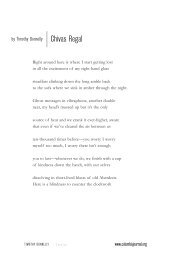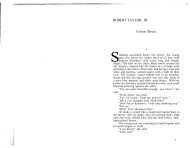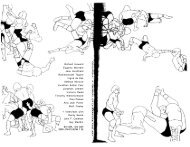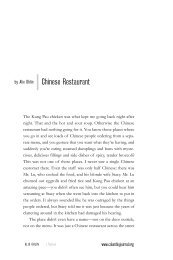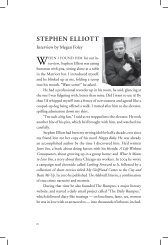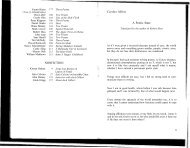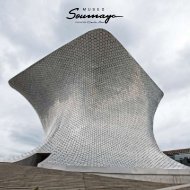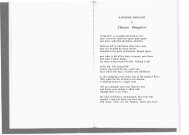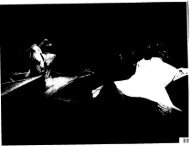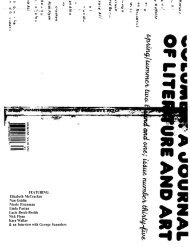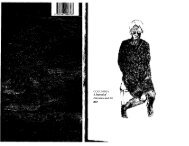Issue 42 - Columbia: A Journal of Literature and Art
Issue 42 - Columbia: A Journal of Literature and Art
Issue 42 - Columbia: A Journal of Literature and Art
Create successful ePaper yourself
Turn your PDF publications into a flip-book with our unique Google optimized e-Paper software.
unrevealed, some so stable that they are caught in acts <strong>of</strong> persistent<br />
coherent revelation. Where structure forms on the LFP page<br />
is a stabilizing area (page refers to the primary residence [home<br />
base] <strong>of</strong> a poem or any <strong>of</strong> its components at any specified<br />
mOInent <strong>and</strong> is not liInited to paper - a poem is able to travel,<br />
even if it doesn't [seem to]). Where structure decays on the LFP<br />
page is a destabilizing area fertile for reformation. Stanzas can<br />
begin out <strong>of</strong> stabilizing gestures, <strong>and</strong> may progress in stability or<br />
may deteriorate, warp, or transform as sOInething from the surrounding<br />
flux (the substance out <strong>of</strong> which structure forms, the<br />
ingredient pool) interacts with the stabilizing (or decaying)<br />
structure. It Inay not be obvious whether a perceptible structure<br />
is stabilizing or decaying as a similar fonn may occur in either<br />
structural state. Structure may attempt to take shape in multiple<br />
locations (rooms) <strong>of</strong> the house <strong>of</strong> the poem, <strong>and</strong> any number <strong>of</strong><br />
these attempts Inay take on enough structure to become perceptible<br />
in part or whole, perhaps causing competing zones <strong>of</strong> influence<br />
which may merge into one structure or may lead to one or<br />
more quick or gradual demises. Or the stability <strong>of</strong> the poem's<br />
structure may be so intense that it delays the stabilizing (<strong>of</strong> other<br />
locations perhaps for so long, the delay mimics prevention), so<br />
that nothing else (at that time) is visible.<br />
A poem as print object documents the dynamic activity that<br />
caused the poeIn to take on perceptible structure, which, like all<br />
structure, is subject to further change, such as revision <strong>of</strong> a print<br />
object <strong>and</strong> interpretations <strong>of</strong> a print object each time it is encountered.<br />
The complete dynamic signature <strong>of</strong> a poem includes all<br />
subsystems <strong>of</strong> the components <strong>of</strong> a poem (the published form a<br />
magnification <strong>of</strong> one <strong>of</strong> the branches in the complete dynamic signature)<br />
which include all drafts, all dead ends, all revisions <strong>and</strong><br />
interpretations (by writer <strong>and</strong> experiencers <strong>of</strong> the poem), all contributing<br />
thoughts, forming a kind <strong>of</strong> evolutionary tree <strong>of</strong> the<br />
poeIn, each branch, when examined closely (magnified, that is, or<br />
considered on some intensified scale), full <strong>of</strong> other branches <strong>of</strong><br />
thought <strong>and</strong> connection. It is through the (so far) ceaseless movement<br />
(transformation perceived <strong>and</strong> actual) <strong>of</strong> dynan1ic systems<br />
that all becomes linked into one fabric <strong>of</strong> reality that is so faceted,<br />
the saIne territory can reveal something different each time the<br />
lens is shifted or changed. Depth in LFP becomes a way to refer<br />
to that which is unexplored, for once encountered, that which is<br />
encountered becomes the surface <strong>of</strong> that encounter. The surface is<br />
hardly superficial but is where interactions between boundaries<br />
occur. Surface after surface is scratched, layer after layer is peeled<br />
back, <strong>and</strong> then there's that rosy resemblance. That elm.<br />
Because poetry is a dynamic system, poems may be understood<br />
as failed efforts to capture flux, as attempts to cause awareness<br />
<strong>of</strong> something that may no longer exist (in that exact form)<br />
by the time a poem is experienced (even during the writing <strong>of</strong><br />
the first line). LFP approaches desired capture <strong>of</strong> a poem as chase<br />
only, so expects to capture only partialities <strong>of</strong> partialities. The<br />
totality in which all apparently takes place can't easily (if at all)<br />
be seen as totality from within it. The most that might be possible<br />
is exquisite failure, <strong>and</strong> most poems fall short <strong>of</strong> that elm <strong>of</strong><br />
failure, some compellingly. II<br />
The Culture <strong>of</strong> Reena <strong>and</strong> the Bear<br />
Before the Bear: derived from a theory <strong>of</strong> gravy<br />
(The neckline <strong>and</strong> hem <strong>of</strong> Reena's gown<br />
were trimmed with real hummingbirds<br />
[just a few tiny pins in the outspread wings<br />
- she could feel the racing unison<br />
that the tiny hearts fell into] <strong>and</strong> actual orchids.<br />
The beak closest to it tried to extract nectar<br />
from the small cleft - the suprasternal notch <br />
at the bottom <strong>of</strong> her perfumed throat)<br />
(Bees drew near; live jewels from the garden.)<br />
She still had her eyes <strong>and</strong> others too<br />
on a tray: unpitted olives<br />
coated with a thin layer <strong>of</strong> meringue<br />
as vitreous humor substitute<br />
Breakfast Before the Bear: ocular effects





